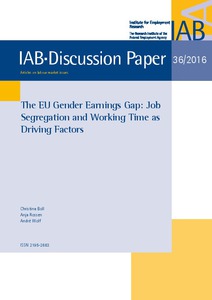The EU gender earnings gap: job segregation and working time as driving factors
"This paper estimates size and impact factors of the gender pay gap in Europe. It adds to the literature in three aspects. First, we update existing figures on the gender pay gaps in the EU based on the Structure of Earnings Survey 2010 (SES). Second, we enrich the literature by undertaking com...
| Main Authors: | , , |
|---|---|
| Institution: | ETUI-European Trade Union Institute |
| Format: | TEXT |
| Language: | English |
| Published: |
Nürnberg
2016
IAB |
| Subjects: | |
| Online Access: | https://www.labourline.org/KENTIKA-020112484839-The-eu-gender-earnings-gap-job.htm |
| Summary: | "This paper estimates size and impact factors of the gender pay gap in Europe. It adds to the literature in three aspects. First, we update existing figures on the gender pay gaps in the EU based on the Structure of Earnings Survey 2010 (SES). Second, we enrich the literature by undertaking comprehensive country comparisons of the gap components based on an Oaxaca-Blinder decomposition. Overall, we analyze 21 EU countries plus Norway, which clearly exceeds the scope of existing microdata studies. Third, we examine the sources of the unexplained gap. We find that about one third of the gap can be traced back to the role of the explanatory factors included in our analysis. The sectoral segregation of genders is identified as the most important barrier to gender pay equality in European countries. In addition, the fact that part-time positions are more frequent among women notably contributes to the gap. We conclude that policies aiming at closing the gender pay gap should focus more on the sector level than on the aggregate economy." |
|---|---|
| Physical Description: | 28 p. Digital |

